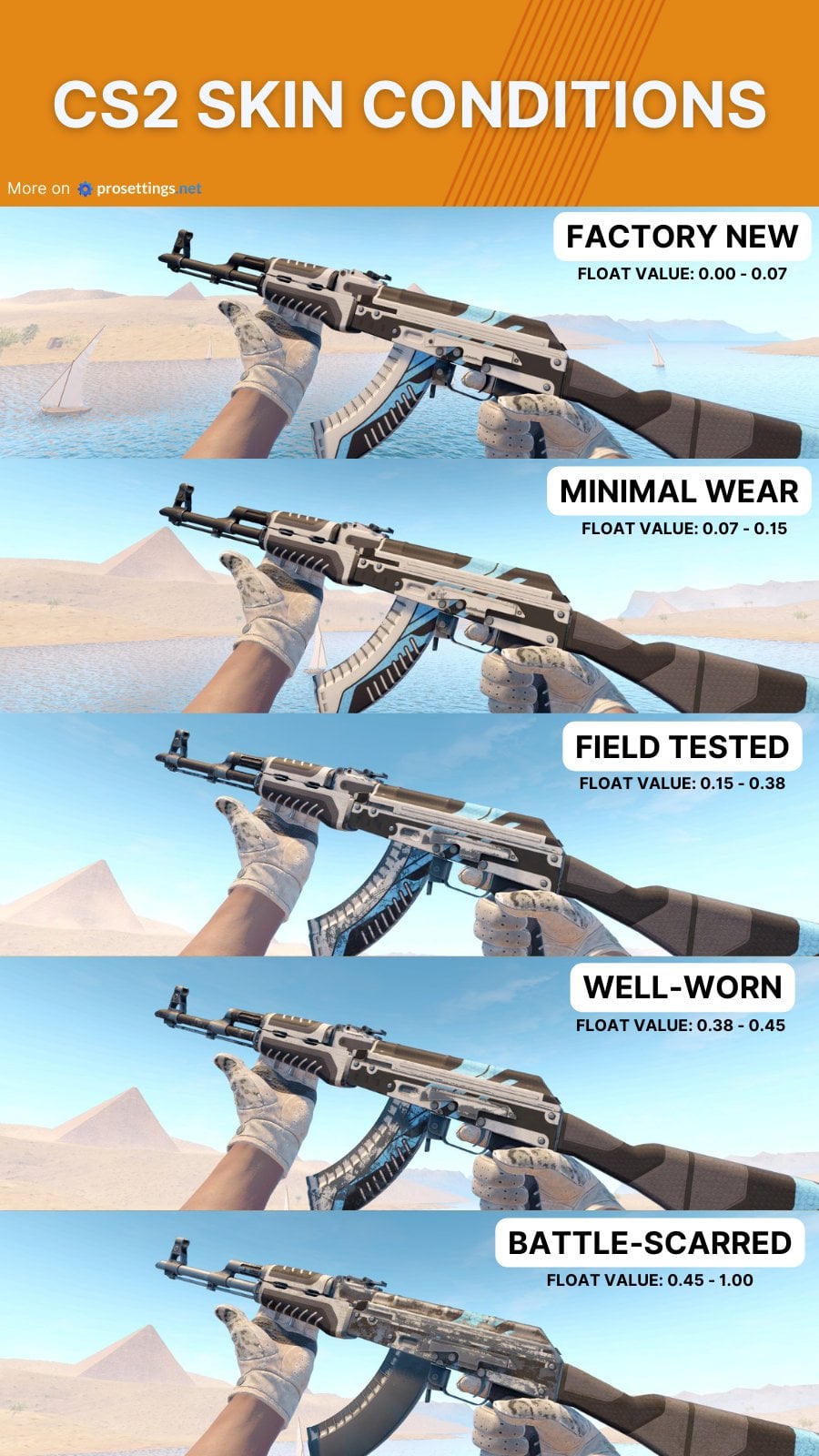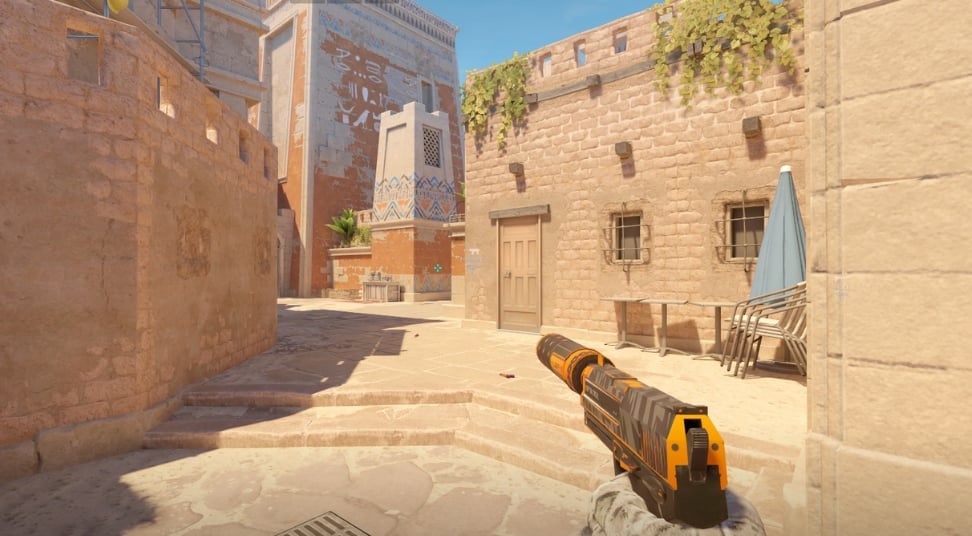Highlights- There are five different CS2 skin conditions: Factory New, Minimal Wear, Field-Tested, Well-Worn, and Battle-Scarred.
- Factory New skins have the least amount of wear and tear, Battle-Scarred skins have the most.
- CS2 skins don’t wear over time: the condition and float value is permanent and cannot be changed.
Counter-Strike 2 has an extremely interesting skins scene. Contrary to what you see in many other games, most CS2 skins are unique. It’s extremely unlikely that you’ll ever encounter a skin that looks the exactsameas your skin, as different skins can have slightly different finish patterns (CS2 Pattern ID Explained) and different wear patterns. In this article we’ll explain the different CS2 skin conditions, ranging from Battle Scarred to Factory New.
Float Values
The condition of a CS2 skin is decided based on its float value. This is a value that randomly gets assigned to a skin when it’s unboxed or dropped from a collection and it’s final: there is no way to change the float value of a skin.
Float values can range from 1.00 (Battle-Scarred) all the way to 0.00 (Factory New) and -generally speaking- the lower the float value of a skin, the less scratches and wear it’ll show.
Related: CS2 Float Values Explained
What Are CS2 Skin Conditions?
As mentioned, CS2 skins aren’t identical. Different skins have different wear values. These wear values indicate how worn the skin looks. A Factory New skin will have little to no scratches and blemishes, while a Battle Scarred skin will look as if it’s been through hell and back.
There are five different skin conditions in CS2:
- Factory New (0.00 – 0.07 float values)
- Minimal Wear (0.07 – 0.15 float values)
- Field-Tested (0.15 – 0.38 float values)
- Well-Worn (0.38 – 0.45 float values)
- Battle-Scarred (0.45 – 1.00 float values)
As you can see, a Factory New skin has a much narrower float value range than, for example, a Field-Tested skin. This makes Factory New skins a lot rarer and thus (generally) more expensive. The fact that most CS2 players prefer pristine looking skins also drives up the price of the better wear conditions, so if you want a Factory New skin you should be prepared to pay extra.

Factory New
These skins look as if they were just purchased and will have little to no scuffs or marks on them. Factory New skins don’t stop at 0.00 float values; there are skins with float values such as 0.00000x. Skins with extremely low float values usually cost more than regular float values due to their rarity, and there are float value collectors who try to get the lowest float skins.
Minimal Wear
If you don’t like to pay full price for a Factory New skin and you don’t mind a couple of tiny dinks and scratches here and there, Minimal Wear is the way to go. Depending on the float value, you can get awfully close to a Factory New look, and Minimal Wear skins with low float values don’t always cost a premium, so if you want to snag a deal it pays off to look at float values when shopping around.
Field-Tested
This is one of the more popular skin conditions since it usually offers a nice balance between price and looks. Whereas Minimal Wear and Factory New skins can come at quite a premium price, Field-Tested skins usually aren’t all that expensive. If you don’t mind the look of a slightly used skin, Field-Tested is the way to go, but do note that there can be a big difference between a 0.07x float value Field Tested skin and a 0.14x float value skin.
Well-Worn
You don’t often see skins in Well-Worn condition since people who go for a good deal tend to go for Field-Tested and people who like a battered and bruised look (or want to get the cheapest option) go for Battle-Scarred. Well-Worn is the least popular skin condition in CS2, so if you’re looking to trade or sell your skins at a certain point this is worth knowing.
Battle-Scarred
The name says it all. Battle-Scarred skins look like they’ve seen a fight or two, and if you like that type of look this is the condition to go for. Note that there is quite a big float value range with Battle-Scarred skins: a skin with a float value in the 0.9x range can even be difficult to identify, whereas a low float value Battle-Scarred skin can still look quite decent. Just like with low float collectors, there are also high float collectors.
Not All Skins Wear The Same
Every skin wears differently. Something like a USP-S Orion is notorious for having a ton of scratches on the slide even in Factory New condition, whereas a Field-Tested AK Empress still looks pristine; it’s just that the paint on the skin gets darker the higher the wear is. This is important to know when purchasing skins: don’t assume that a Factory New skin will have no scratches on it at all, and don’t think that a Field-Tested skin will always look messed up.
How a skin wears is decided by its creator, so it’s a good idea to research a bit before buying a new skin. If the skin line you’re interested in doesn’t really get any scratches with higher float values, you might be able to save some money by going for a worse wear condition.
Pictured below: a factory new USP-S Orion with a lot of scratches on the top.

Different Pattern IDs
See: CS2 Pattern ID Explained
Aside from the float value (which, as discussed, decides the skin condition) skins also get assigned a pattern ID when they first get dropped or unboxed. This, like the float value, is random and cannot be changed.
Important to note here is that different patterns wear differently. A famous example of this is the Karambit. The playside corner of a Karambit can look quite scratched up even in Factory New condition, and the look of a corner is partially decided by the pattern ID. A Karambit with a Float Value of 0.35x might have a near flawless corner, while another Karambit with a float value of 0.035x might have a completely messed up corner.
Conclusion
Simply put: wear conditions are a way of classifying different float value ranges for CS2 skins in order to make things a little easier to follow for casual skins enthusiasts. The wear condition of a skin is based on its float value.
Former semi-pro gamer turned writer, product reviewer, and community manager.
Thanks! Just started CS2 (I played a tiny bit of CS GO before tho) and wanted to know what all this stuff meant lol.
Glad to know it helps!